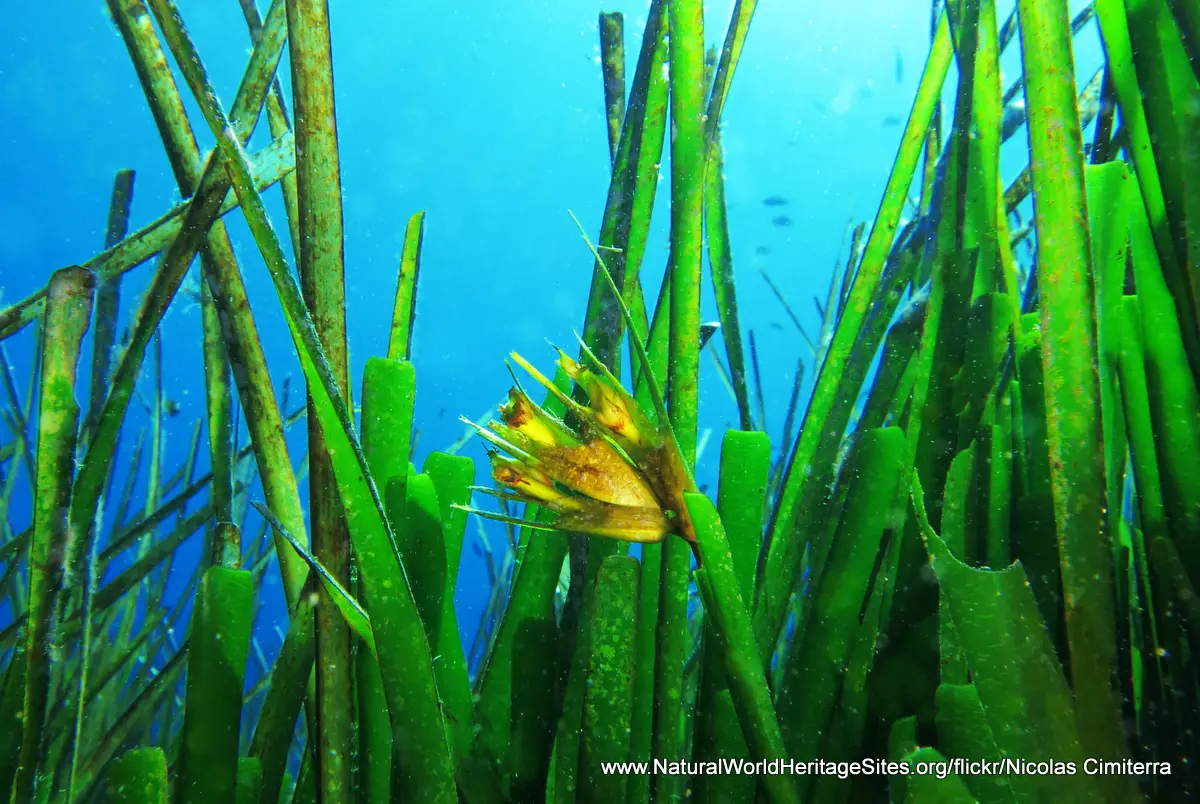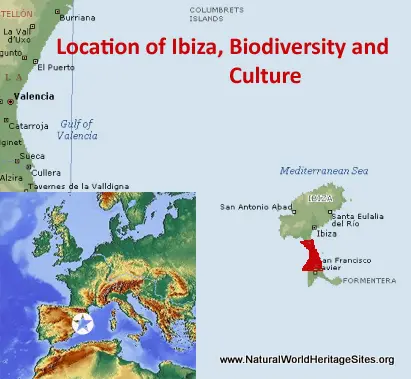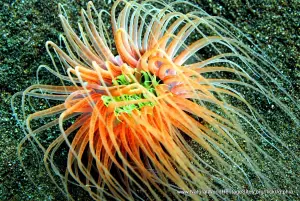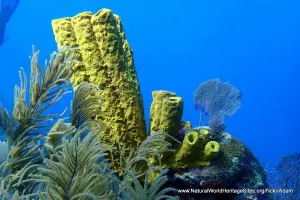EXPLORE Ibiza, Biodiversity and Culture with this slideshow, check the location map and get all the facts and information below.
For slideshow description see right or scroll down (mobile). Click to view slideshow
Location and Values: The site known as ‘Ibiza, Biodiversity and Culture’ is included on the world heritage list as a ‘mixed’ site that satisfies both natural and cultural criteria. It covers parts of Ibiza and Formentera, as well as the small islands of Penjats, Espardel and Espalmador, together with the portion of sea between them, in the Balearic Islands of the western Mediterranean Sea, about 100 km from the Spanish mainland. Its cultural attributes include the archaeological sites of Sa Caleta and Puig des Molins (dating from the Phoenician-Cartheginian period) and the fortified Upper Town (which exemplifies Spanish Renaissance military architecture). However, the focus here is on natural attributes, which are associated with the site’s marine environment, especially the remarkable seagrass prairies and coral reefs that are protected here, together with the coastal saltpan lagoons on the main islands.
The most important marine habitat is the submarine prairie of Posidonia oceanica, a type of seagrass that is found only in the Mediterranean basin and is under extreme threat from pollution in other parts of its range. These prairies serve as a hatchery and nursery for many species of marine fish, thereby helping to sustain commercially-important fish stocks outside the site. The ecosystem has remarkably high biological productivity generating about 21 tons/year of biomass, similar to that of a tropical forest. In addition to the seagrass prairies the site includes two other important marine communities, one based on the colonial coral (Cladocora caespitosa, with its association of 220 other species) and the other formed by the colonial sea squirt (Ecteinascidia turbinata, which produces a chemical valuable in the treatment of cancers). The seas around the site sustain a population of Mediterranean monk seals, one of the twelve most endangered mammals in the world. The terrestrial part of the site includes coastal lagoons and saltpans which are important as a major resting area for migratory waterfowl, and there are large breeding colonies of sea birds elsewhere, including Balearic, Yelkouan and Cory’s shearwaters, storm petrels, Audouin’s and Caspian gulls.
Conservation Status and Prospects. According to IUCN’s Conservation Outlook Assessment (2020) the conservation status of the ‘Ibiza, Biodiversity and Culture’ world heritage site is of ‘significant concern’. The IUCN report notes that the site is highly threatened by a number of factors, and its world heritage values are deteriorating, perhaps approaching a critical point. There is particular concern over the status of the seagrass prairies and declining populations of Balearic shearwaters.
The IUCN report identifies six main threats related to the (1) impacts of tourism, (2) invasive alien species, (3) pollution of the marine environment from discharge of poorly treated sewage, (4) climate change, (5) the potential for shipping accidents and (6) impacts from infrastructure developments such as the installation of a submarine electric cable and oil exploration in the Ibiza channel. The management response to these escalating threats has so far been inadequate and improvements are urgently required if the site’s world heritage values are to be fully restored and maintained.
Links:
Google Earth
Official UNESCO Site Details
IUCN Conservation Outlook
UNEP-WCMC Site Description
Birdlife IBA
Slideshow description
The slideshow ‘tells the story’ of Ibiza’s ‘Biodiversity and Culture’ world heritage site with a portfolio of photos that illustrate the main features that underpin its listing under natural criteria. It starts with a series of photos to illustrate the importance of the Posidonia seagrass prairies as seen from the coast, and underwater. A lot of dead seagrass is washed up on the sandy beaches, where it contributes to complex food webs and may blow in the wind creating balls of fibre. The next part of the slideshow provides an introduction to the underwater world of the open waters and coral reefs where bottlenose dolphins, jellyfish, groupers, anemones, fan worms, hermit crabs and moray eels are amongst the species shown. A popular boat tour takes visitors round the island of Espalmador and the next part of the slideshow illustrates the rocky shoreline here with its caves and dark underwater overhangs. One of the caves is occupied by a Mediterranean monk seal pup, while an adult is basking on a nearby beach. There are further images of the site’s marine biodiversity and coral reefs, with octopus and fish demonstrating their camouflage, while brightly-coloured nudibranchs (looking like underwater slugs) patrol the depths as a variety of anemones wave their tentacles searching for prey. The final part of the slideshow provides images of the rocky coastline of Formentera, one of the salt-pans with a typical small wading bird, a popular sand beach crowded with people and further underwater views of the seagrass prairie environment.
The following Flickr photographers are acknowledged with thanks for their contributions to this slideshow: Canon/J.L.Mera, Ivan Zanotti Photo, Nacho Pintos, xusme, Manuel Sanchez Mateos Paniagua, Joaquim F.P., Martino Sabia, vivtony00, Andrea Nani, _nodata_, Wildlife Wanderer, Ryan McMinds, Watt fur Bilder, Marta Terry L., Cristina Pla, lula1977, Risto Silaste, AH-AP, Nicolas Cimiterra, Mykle Hoban, Nicholas Turland and Rafael Medina.
Factfile
Website Category:
Marine & Coastal
Area: 90 km2
Inscribed: 1999
UNESCO Criteria:
- Ecological processes (ix);
- Natural habitat for biodiversity (x);
- Cultural criteria (ii, iii, iv)





